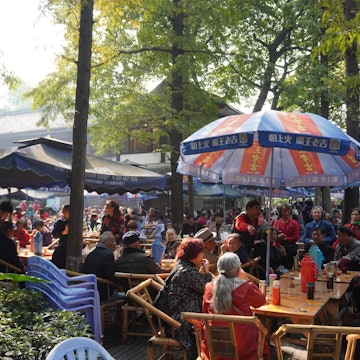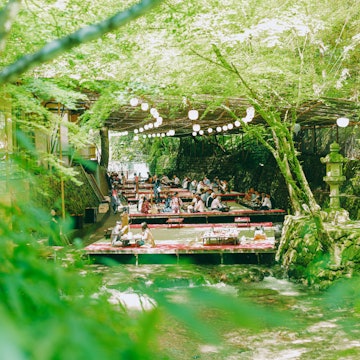
Noodles, clams and wonton debauchery: six must-try dishes in Hoi An

Feb 1, 2019 • 5 min read

Cao lau noodles, just one of Hoi An's eclectic and delicious dishes © James Pham / Lonely Planet
Hoi An is a town unlike any other in Vietnam. Once the commercial capital of the Champa Empire, a seafaring people who ruled over Vietnam’s central coast, it became a busy port city between the 16th and 18th centuries.

People from all over the country migrated to Hoi An to cash in on the town’s prosperity, adding their regional dishes to the international flavours brought by the merchants who settled, including the Chinese, Portuguese and Japanese. The result is an eclectic food scene where the people of Hoi An have blended influences together while giving the dishes their own local spin.

Cao lau noodles
The name cao lau – literally 'high floor' – points to the riverside eateries where seafaring traders would tuck into a bowl of chewy noodles while waiting for their goods to be offloaded. The firm, broad noodles, somewhere between Chinese flat noodles and Japanese buckwheat soba, are made from rice which is soaked in water from the ancient Ba Le Well (dating to Cham times) mixed with ash from trees from the Cham Islands, just off Hoi An’s coastline. This combination means authentic cao lau can really only be found in Hoi An.
The noodles are topped with slices of pork marinated in five-spice powder, blanched bean sprouts, fresh herbs and a light gravy for a one-bowl meal.
Try them at Cao Lau Thanh (26 Ð Thai Phien) where wonderfully rustic bowls are served under the shade of a big tree after 4pm.

Chicken and rice
Hoi An’s version of chicken and rice is famous for extracting every drop of flavourful goodness from the chicken.
The dish starts off with free-range chicken chosen for its chewy meat and intense flavour. The broth from boiling the chicken is then used to cook the rice, which has typically been aged for at least a year, allowing the grains to dehydrate and soak up even more of the broth. Some places will roast the rice grains to further dry them out. The plump cooked grains don’t stick together like regular rice, while a dash of turmeric adds a pretty yellow hue. The bones and gizzards of the chicken are used to make a gravy to ladle over the rice and shredded pieces of chicken, surrounded by a bed of fresh herbs and sliced onions. More chicken broth is used as the base for a vegetable side soup that helps wash it all down.
Try hoi an chicken & rice at Com Ga Xi at the entrance to the alleyway at 47/2 Ð Tran Hung Dao.

Minced clams and 'smash' crackers
The picturesque Thu Bon River, which runs along Hoi An’s Old Town, is also the source of tiny clams that make up hen tron, a tasty snack of lightly sautéed clams. The clams, collected by village women in the early hours of the morning, are cleaned and the meat is extracted and simply fried with minimal seasoning to showcase its flavour, all topped with peanuts and fresh herbs.
Often accompanying the minced clams are banh dap, literally 'smash' crackers, an alternating stack of crunchy, grilled rice paper and soft, steamed rice flour. Part of the fun is using your hand to smash the crackers into bite-sized pieces, creating a contrasting texture of crispy and gummy. The crackers are dipped into a pungent fermented anchovy sauce complemented by crispy-fried shallots and spicy Hoi An-style chilli sauce.
Just south of the Old Quarter, cross the Nam Cam Bridge to the nearby river island of Nam Cam. At a cluster of around ten small riverside eateries you can snack on minced clams and smash crackers while lazing in a hammock with views of the Hoai River, a tributary of the Thu Bon.

Sizzling pancakes
You can find banh xeo – literally 'sizzling pancakes' for the sound they make in the pan – all over Vietnam with variations by region. The Hoi An version is much smaller (about the size of your hand) than its giant Ho Chi Minh City cousin. A rice-flour batter tinged yellow with turmeric is ladled into a searing hot pan with a shrimp, pork and sometimes squid filling along with fresh bean sprouts. The ideal banh xeo is crispy on the outside and moist in the middle.
Break off a piece and wrap it in a lettuce leaf along with fresh organic herbs from the nearby village of Tra Que, famous for using local seaweed to fertilise its aromatic greens. Instead of the usual clear fish sauce, the Hoi An dipping sauce is thick and deliciously gritty, made from soy beans, minced pork and pork liver.
Try it at Ba Le (45/51 Ð Tran Hung Dao) where an all-you-can-eat set comes with sizzling crêpes, shrimp spring rolls, grilled pork skewers and dessert. As you’re waiting for your food, walk across to the open kitchen where you can watch the cook frantically managing up to a dozen pans at once. If you come when it’s still light, stop by the next alleyway to see the famous, yet surprisingly unadorned, Ba Le well, the water source for Hoi An’s cao lau noodles.

Fried wontons
It’s said that wontons originated in Guangzhou, China and made their way to Vietnam, where they can now be found everywhere in noodle soups. Hoi An has put its own spin on this ubiquitous dish, deconstructing it by frying the wonton wrapper and using it as an open-faced base on which to pile a tasty mix of sautéed pork, shrimp, bell peppers and onions in a tangy sweet and sour tomato sauce.
Try it at Spice Viet, where fried wontons and other Hoi An specialties are given a healthier twist using mainly locally-sourced, organic ingredients.
https://shop.lonelyplanet.com/products/vietnam-travel-guide-14














